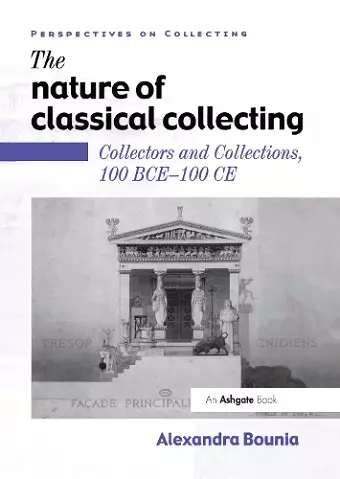The Nature of Classical Collecting
Collectors and Collections, 100 BCE – 100 CE
Format:Hardback
Publisher:Taylor & Francis Ltd
Published:28th Oct '04
Currently unavailable, and unfortunately no date known when it will be back

The phenomenon of collecting as a systematic activity undertaken for symbolic rather than actual needs, is traditionally taken to originate in the middle of the fifteenth century, when the first cabinets of curiosities appear in Italy. Yet it is clear that the practice of collecting started long before that, indeed its origins can be traced back thousands of years to European prehistoric communities. Whilst this early genesis is, due to lack of written records, still shrouded in much mystery, The Nature of Classical Collecting argues that the collecting practices of classical Greece and Rome offer a rich tapestry of experiences which can be reconstructed to illuminate a pivotal period in the long and ever developing phenomenon of collecting. Utilizing a wide variety of examples of classical collections - including grave goods, the accumulations of Greek temples and open-air shrines, the royal collections of Hellenistic kings, Roman art and curiosity collections, and relics - The Nature of Classical Collecting focuses on the field of the 'pre-history' of collecting, a neglected yet critical phase that helped crystallize the western concept of collecting. Drawing primarily on Latin writings from the period 100 BCE to 100 CE it shows how collecting underwent a transition from a religious and political activity, to an intellectual practice in which connoisseurship could impart social status. It also demonstrates how the appreciation of objects and artists changed as new qualities were attributed to material culture, resulting in the establishment of art markets, patronage and an interest in the history of art. By exploring these early developments, The Nature of Classical Collecting not only provides a fascinating insight into the culture of late Hellenistic/early Imperial Roman collecting, but also offers a much fuller grounding for understanding the influences and inspirations of those Renaissance collectors who themselves were to have such a profound influence on the course of European art, architecture and culture.
'Museology students will find the theoretical introduction and discussions of methodological approaches especially useful. Anyone with an interest in the history of museums will be able to mine the text for fascinating facts and insightful ideas, and gain an overall impression of a collecting period that has remained hidden up until now.' Museum and Society
ISBN: 9780754600121
Dimensions: unknown
Weight: 639g
370 pages